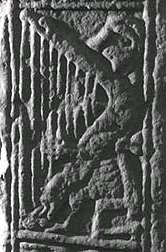 |
| Generic replica bone-flutes |
Although extensive use of musical instruments is well evidenced in the Classical Era, especially amongst the Ancient Greeks and Romans, evidence of music in Europe following the fall of Rome is scarce. Did this most complex expression of culture simply die with the Classical Age, only to tentatively re-emerge through the Medieval Age and Renaissance following the "Dark Ages"?
In short, no. There is excellent evidence to challenge the widespread notion that the early Middle Ages were a "Dark Age" of cultural ignorance and regression, not least the unparalleled art of this age seen in finds such as those of the Staffordshire Hoard. There is now strong evidence that the germanic peoples of the Middle Ages had distinct, sophisticated cultures, expressed in a range of forms including music.
"Scopes" were professional storytellers, poets and musicians (known amongst the Vikings as "Skalds"), who made their living either selling performances, or under the regular employ of a thegn or aethling. The existence of a class of paid performers is evidence of the key role music and verse likely played in the lives of the people of the Middle Ages, and it seems likely that such people would've carried tools of their trade; instruments sufficiently versatile as to allow them to put on performances worth hearing.
Finds of whistles or flutes fashioned from bone are fairly common at archeological sites from this period, although with few holes to allow alteration of notes, these could hardly have been useful for performances. Such instruments were likely also made from wood, but these don't survive.
Blowing horns are known to have been used by the Anglo-Saxons and their continental counterparts, and are also associated with the Vikings. Probably used for directing troops, alerts, or to intimidate foes, referring to these as "musical instruments" is charitable at best.
Many mentions of "hearpe" are made in literary sources from the Anglo-Saxon age; Bede's Ecclesiastical History of Britain, recalling the life of the 7th century poet Caedmon, tells of his shame at lacking the ability to "sing to the harp" before he, eventually, received inspiration from the almighty. In Beowulf, harps and performance of music are mentioned frequently. One such reference is made early on, in describing the events preceding Grendel's attack on Herot;
The instruments referred to in these texts for a long time remained a mystery.
Ðá se ellengaést earfoðlíce þráge geþolode sé þe in þýstrum bád þæt hé dógora gehwám dréam gehýrde hlúdne in healle· þaér wæs hearpan swég swutol sang scopes With envy and anger an evil spirit endured the dole in his dark abode, that he heard each day the din of revel high in the hall: there harps rang out,
clear song of the singer.
Since the discovery of the first "hearpe" at Sutton Hoo, many more examples have been discovered across England, Germany and Sweden. Were these the "hearpan" mentioned?
 |
| Sutton Hoo "Hearpe" |
It's believed, therefore, that these instruments would've been used to punctuate stories and poetry such as Beowulf, with short melodies, strumming and blocking; rhythm and tone intended to enhance the atmosphere of the hall, and supplement the storyteller's descriptions of scenes and events. The fact that such an instrument was found amongst the burial goods of a king is strong evidence that even royalty would participate in the performance of music and poetry. Music would likely be a common pastime amongst individuals of high status or wealth, who could afford carefully crafted instruments and sufficient spare time to master them. Despite this, it's unlikely the king of an Anglo-Saxon kingdom would have sufficient time for vocal training or mastery of a more complex instrument.
It seems that the Sutton Hoo style harp was perfect for use at a feast, or to add atmosphere to storytelling; an instrument that could be easily played as a hobby, but probably not sufficiently versatile to make a living from.
 |
| Dupplin Cross, Scotland, circa 800 AD |
What, then, for the references in Beowulf that very clearly state harps were sung to?
Barring some sort of symbolic convention, there seems no logical reason why a harp would always have had 6 strings and no more, and as we have established, the Sutton Hoo harp seems perfectly designed for the role it likely played in feasts and storytelling. For a career performer, a more complex instrument would be a necessity, and with such an item representing the livelihood of a scop's family, it's unlikely that such insturments would've ever been included in grave-goods (from which most of our archeological evidence originates). What's more, scops would be unlikely to have afforded the metallic decoration and other components that in the case of Sutton Hoo survived and enabled reconstruction. Made of wood and gut-strings, any evidence of the instruments of scops is likely long-gone.
 |
| Monifeith Pictish stone, Scotland, 700-900 AD |

